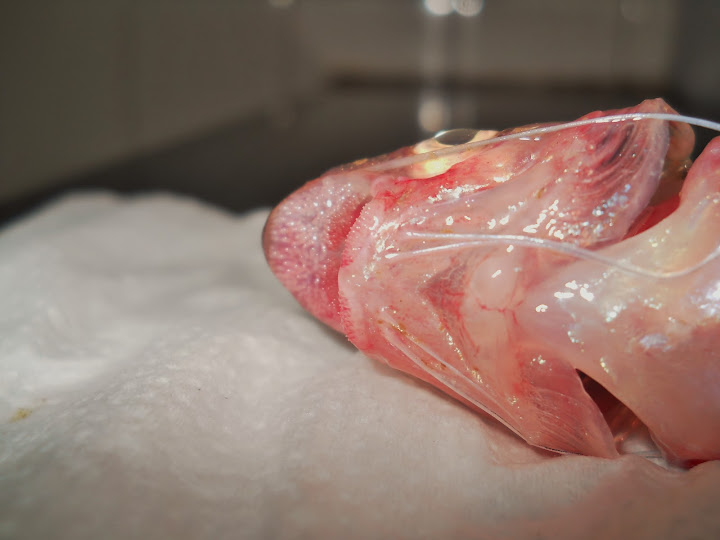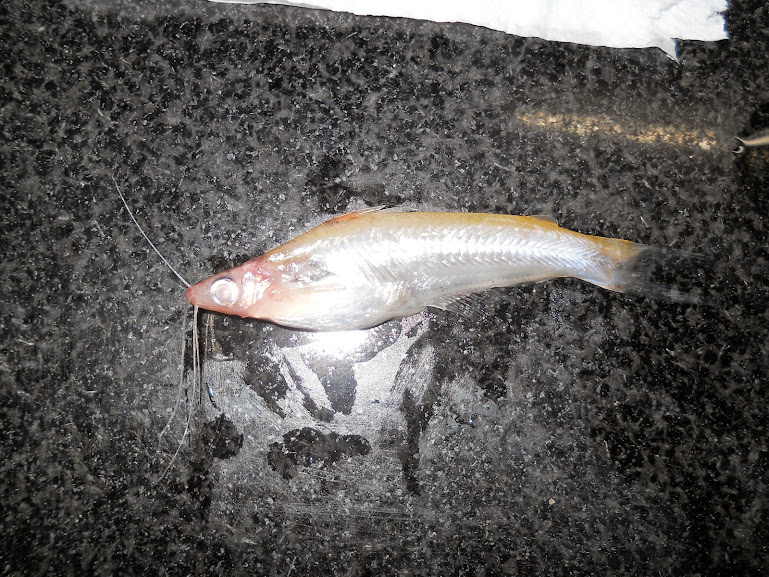Page 1 of 1
Neotropius khavalchor
Posted: 08 Jun 2013, 02:15
by Shovelnose



Specimen from the Tungabhadra (Krishna Drainage).
This species seems to be very common in the Tungabhadra and grows bigger than I thought (biggest specimen seen was around 4-4.5 inches TL). These are also
extremely hardy fish. We picked up a couple that had been drying in the sun for quite a while and one of them almost made it back home. Had it lived, it would have been a very interesting fish to keep (khaval=scales;chor=thief).
Re: Neotropius khavalchor
Posted: 08 Jun 2013, 05:58
by Silurus
As I recall, relatively large
Neotropius atherinoides also display the protruding snout. Specimen from market in Kolkata (reddish hue is a postmortem artifact):


Re: Neotropius khavalchor
Posted: 08 Jun 2013, 07:17
by Shovelnose
Oh, so is there no reliable way of telling them apart unless we collect smaller specimens with protruding snouts??? All the larger specimens did have a bit of colour on the fins while the smaller specimens were 'bland'.

This is what we thought was
N.atherinoides (and hence, didn't spend too time taking good pictures

).
Re: Neotropius khavalchor
Posted: 08 Jun 2013, 09:40
by Silurus
I am not 100% convinced that the small, shorter-snouted fish and the large, long-snouted one are the same species, but the fact is I do not know of any small, long-snouted individuals makes me lean towards considering them conspecific.
Re: Neotropius khavalchor
Posted: 10 Jun 2013, 04:50
by Shovelnose
I will keep a look out for any specimens from north India as well.
This specimen was around 3 inches TL. Do you think this qualifies to be a large specimen with a small snout???
Re: Neotropius khavalchor
Posted: 10 Jun 2013, 08:42
by Silurus
IIRC, the specimen in my photo is about 4" SL. The irritating thing is that I cannot find any specimens (whether short or long snouted) between about 2.5" SL and 4" SL.
Re: Neotropius khavalchor
Posted: 10 Jun 2013, 14:55
by Shovelnose
Silurus wrote:The irritating thing is that I cannot find any specimens (whether short or long snouted) between about 2.5" SL and 4" SL.
Getting specimens from north India will be fairly easy for me now, lets see what I come up with. I will also try to get pictures of small sized specimens from south India.
Re: Neotropius khavalchor
Posted: 21 Jul 2015, 15:08
by coelacanth
Did anything more come of this? I've always been interested in this supposed lepidophage.
Re: Neotropius khavalchor
Posted: 21 Jul 2015, 17:43
by Viktor Jarikov
My first thought was "Do they eat fat?" But of course lipid and lepid differ.

You had me look it up. Interesting.
https://en.wikipedia.org/wiki/Lepidophagy
Lepidophagy is a specialised feeding behaviour in fish that involves eating of scales of other fish.[1] Lepidophagy is widespread, having been independently evolved in at least five freshwater families and seven marine families.[2] Lepidophagy has been reported in a range of fish including: Chanda nama (family Ambassidae),[3] Terapon jarbua (family Terapontidae),[1] several marine catfish (family Ariidae),[4] some piranha, Exodon paradoxus and Roeboides species (family Characidae),[2][5][6] along with Perissodus eccentricus, Perissodus microlepis, Plecodus elaviae, Plecodus multidentatus, Plecodus paradoxus and Plecodus straeleni (family Cichlidae).[7][8]
Fish scales are a surprisingly nutritional food source, containing layers of keratin and enamel, as well as a dermal portion and a layer of protein-rich mucus. They are a rich source of calcium phosphate.[2] However, the energy expended to make a strike versus the amount of scales consumed per strike puts a limit on the size of the lepidophage; such fish seldom exceed 20 centimetres (7.9 inches) and most are under 12 cm (4.7 in).[2] There are a number of advantages to consuming scales: scales are common, covering the body of most fish species, can be regrown relatively quickly by "prey" fish, are abundant and seasonally reliable, and their removal requires specific behaviors or morphological structures.[2]
A diversity of morphologies and attack behaviors are used by lepidophagous predators. The behavioral origins of scale feeding may be different for different lineages.[2]
Re: Neotropius khavalchor
Posted: 28 Jul 2015, 10:33
by Shovelnose
coelacanth wrote:Did anything more come of this? I've always been interested in this supposed lepidophage.
I only encountered a few
N.atherinoides (from south India) after this. I am now in Bombay (western India) and the type locality of
N.khavalchor is just an overnight journey away. I will be travelling there in ten days and will update this thread if I encounter these fish again.
Re: Neotropius khavalchor
Posted: 28 Jul 2015, 10:35
by coelacanth
Great, look forwards to hearing more.

